Chance Duperreault, a fire inspector in Canada, sent me today’s Wordless Wednesday photos of a fire door assembly that was repaired using screws to fill the existing fastener holes. NFPA 80 states:
When fastener holes are left in a door or frame due to changes or removal of hardware or plant-ons, the holes shall be repaired by the following methods:
(1) Install steel fasteners that completely fill the holes.
(2) Fill the screw or bolt holes with the same material as the door or frame.
(3) Fill holes with material listed for this use and installed in accordance with the manufacturer’s procedures.
Assuming that the screws in the photos are steel, and considering that NFPA 80 doesn’t limit the number of holes or screws, do you think this repair is compliant with the standard?
You need to login or register to bookmark/favorite this content.

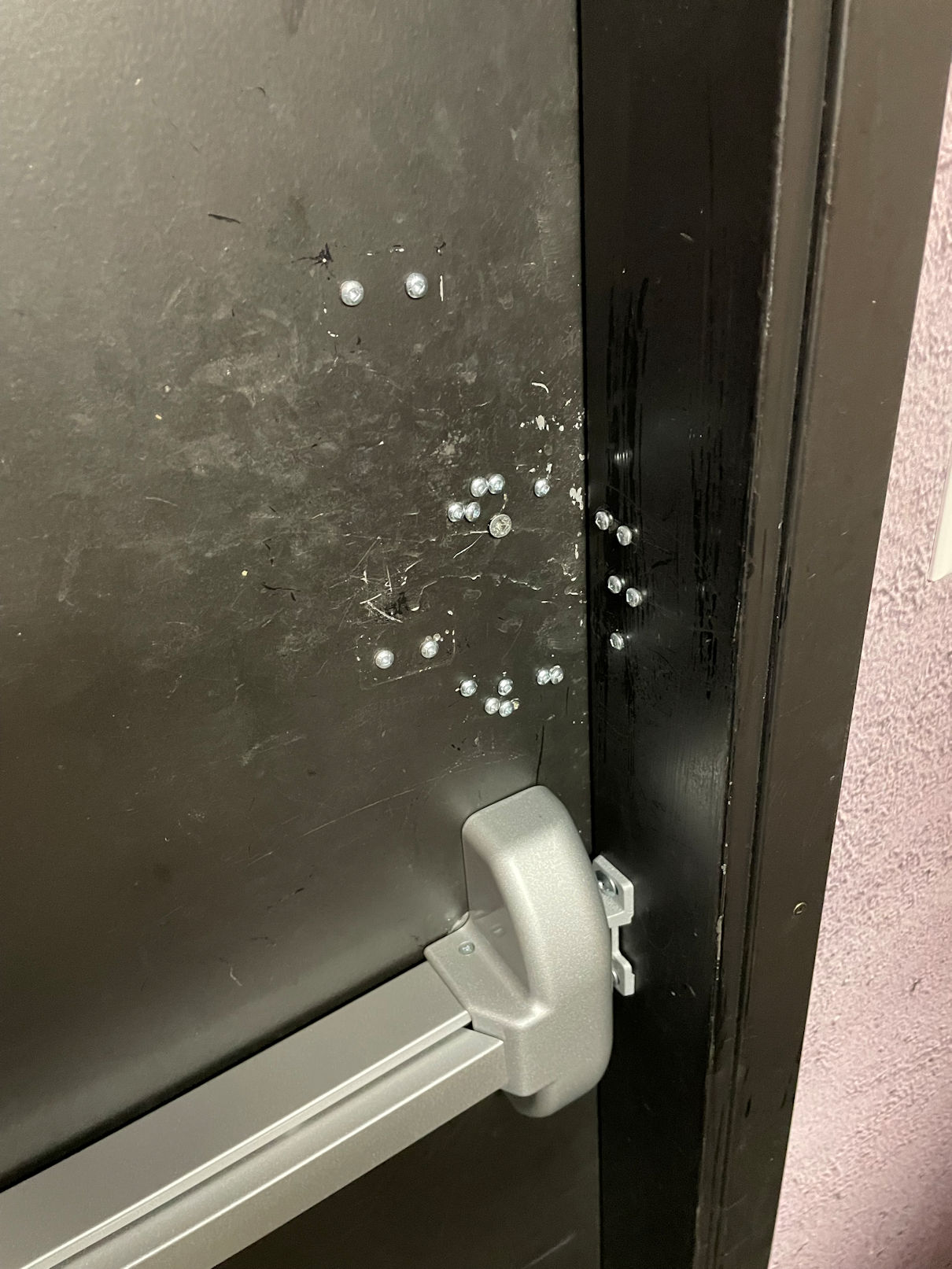

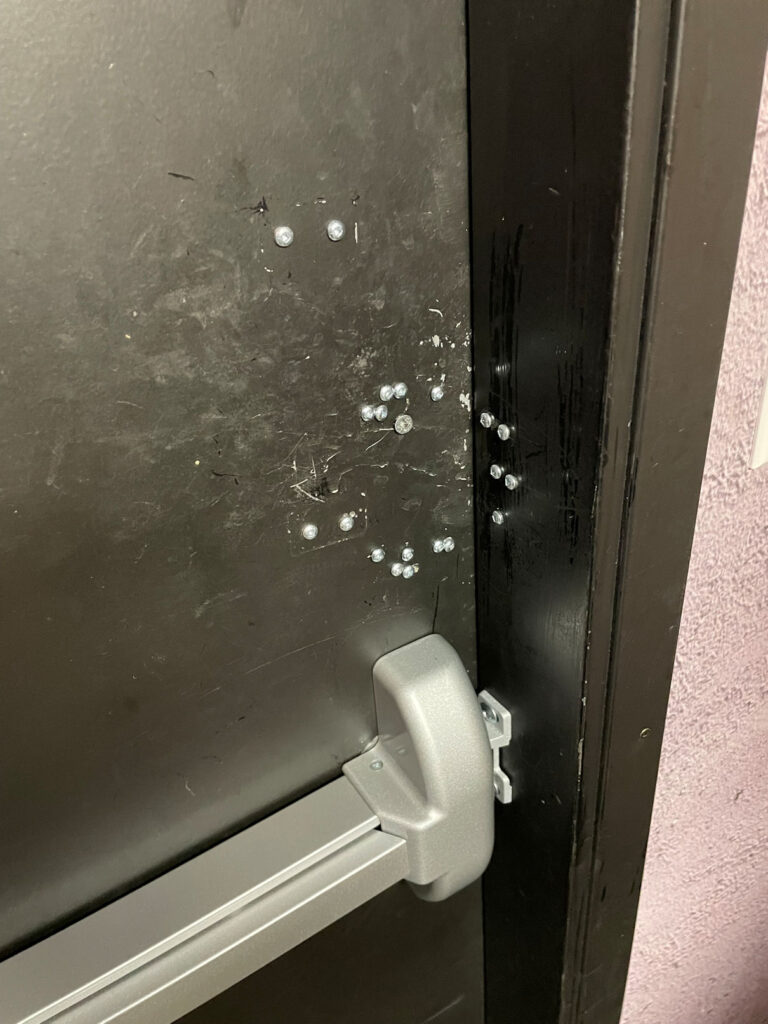

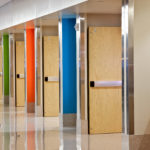
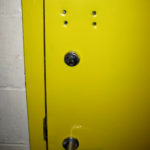
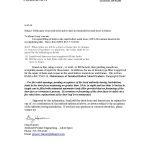




WTH…
Yes, I think this is compliant but looks like crap. sometimes budgets play a big part in repairs.
I have been in similar situations. You have to do what the customer wants if it is compliant. and truthfully in a mechanical room, or such out of public view do not blame the owner. I may do the same
The Door Mfg. that submitted the assembly for UL testing has the only opinion that matters!
Hmmm…I don’t believe there is anything stated as to the maximum number of holes in the door than can be filled. However, at some point there is obviously a compromise in the integrity of the door. Your picture is one example that raises debate, but what if the door had (50) 1/4″ holes in it? Would we still say it’s acceptable? This is a condition that should be clarified in a future revision of NFPA 80. Until then, I agree with the prior comment that one should consult the door manufacturer. Amazing what we all run into out in the field.
Hey Lori! One thing I always wonder every time I read “Fill the screw or bolt holes with the same material as the door or frame” I wonder how specific that is. Do the screws need to be the same grade of steel as the door? Or will any steel screw work for any steel door?
Hi Matthew –
Since the steel fasteners are a separate option from filling the holes with same material as the door or frame, I would say any steel fastener that completely fills the hole would be acceptable.
– Lori
Two thoughts.
First, it’s a trick question. NFPA doesn’t apply because the door is in Canada! While their codes reference the NFPA, they have their own codes. For example, the Canadian National Fire Code.
Second, on a serious note, isn’t there more to the analysis? The holes obviously aren’t from a job-site preparation, which makes them a field modification. I’ll go out on a limb and say the manufacturer probably didn’t give advance permission to make the modifications, so drilling the holes violates NFPA. I don’t know the answer to this question, but if the door was initially modified in such a way to violate NFPA, does filling the holes (which weren’t permitted in the first place) bring the door back into compliance?
Good point, David!
But NFPA 80 is referenced in at least some of the Canadian provincial codes. This blurb came from the National Fire Code of Canada:
Non-Canadian Standards: A number of subject areas for which the Canadian standards development organizations have not developed standards are covered in the NFC. In these cases, the Code often references standards developed by organizations in other countries, such as the American Society of Heating, Refrigerating and Air-Conditioning Engineers (ASHRAE) and the National Fire Protection Association (NFPA). These standards are developed using processes that may differ from those used by the Canadian standards development organizations; nevertheless, these standards have been reviewed by the relevant standing committees and found to be acceptable.
The holes could have been allowed as a job-site preparation if they were used to attached surface-mounted hardware, no? I would guess that the surface-mounted hardware was not listed to UL 10C, but the section of 80 that addresses filling holes with steel fasteners says, “When fastener holes are left in a door or frame due to changes or removal of hardware or plant-ons…” It doesn’t specify that the hardware that was removed was listed. Kind of a grey area, I guess.
– Lori
Hey David, I’m a little late to the party here but NFPA 80 is enforceable through the National Fire Code of Canada. No trick question here!
These holes were caused by improper hardware installed over and over and over again until they finally got it right. (if you can call this right) I believe the holes were from a job-site preparation for surface mounted hardware.